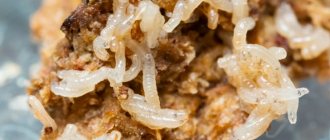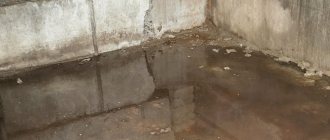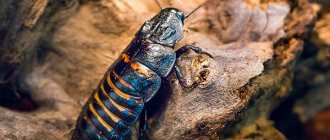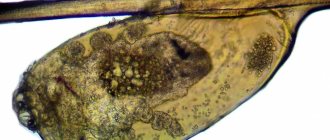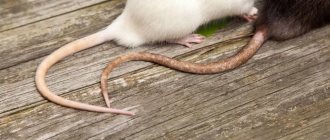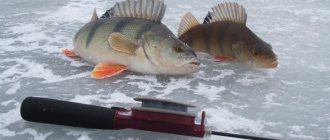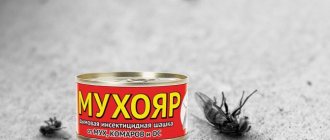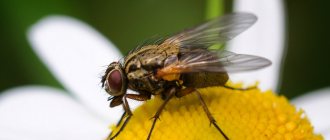Flies, like mosquitoes, are part of the order Diptera (Diptera), class Insects. They have two front wings, the hind wings have been transformed into balance organs - halteres.
Dipterologists (Diptera specialists) cannot name the exact number of species. It is known that 28 families of these insects number over 30 thousand groups.
Interesting fact. In a list of new species of plants and animals released by Australian scientists in 2021, some flies were named after heroes of the MARVEL multiverse.
Types and habitat of insects
Representatives of Diptera are distributed everywhere, except Antarctica and the Arctic zone, and live in the wild and near humans. The latter are called synanthropic and are divided into 3 groups:
- village: habitat – populated areas, for example, Musca domestica (indoor);
- semi-settlement: live and reproduce in settlements and in nature – Callphoridae (meat-bearing);
- pasture: develop in the droppings of cows and sheep on pasture - Wohlfahrtia magnifica (Wohlfahrtia).
How and why flies are bred
This is the story of entrepreneur Igor Istomin, who built a real fly farm. Igor explains why flies are not really disgusting, how larvae help little piglets and chickens survive, and why a small factory for the production of insect larvae should someday appear in every poultry farm.
As a child, I had one strange thing. More precisely, I had a lot of strange things, but now I will tell you only about one. I really liked flies. My parents hung Velcro insect repellents in our country house, and from time to time, half-immobilized, unhappy, and dying flies would fall onto the table. I picked them up and put them in a transparent box with holes for air - it was a hospital. When another insect, despite all my efforts, still died, I seemed to be very upset. I also liked to put a fly on my hand and watch it crawl along it - it felt pleasantly ticklish to my hand. You must have grimaced, reader? That's how my parents grimaced. And they said: “Julia, do you have any idea WHERE they walked with those paws?”
It is generally accepted that adults understand everything better, and children should listen to them without asking unnecessary questions. But when it comes to flies, at five years old I seem to be closer to the truth than my parents.
“You know, Yulia, people very strongly believe in different stereotypes,” Igor Istomin, the founder of a small farm where fly larvae are bred to create environmentally friendly biofeeds and fertilizers, tells me. “When you tell people about flies, they immediately imagine all sorts of sewage, toilets and rot. But, firstly, if it were not for these insects, our planet would long ago have been covered with a many-kilometer layer of corpses, because they would have been processed much more slowly. And in general, research has long proven that there is an antimicrobial environment around every fly.
Yes, this insect climbs through garbage dumps, but then it carefully washes its legs, which have thin chitinous hairs. These hairs secrete a microsecretion that disinfects everything. And in Napoleonic times, fly larvae were used to clean hard-to-heal wounds - they perfectly remove necrotic tissue and keep living tissue intact. Microsecret is rich in immunomodulators, and healing occurs faster. In America, this method is still sometimes used in surgery today.
Until 2014, Igor Istomin was engaged in household appliances, but with the onset of crisis times he decided to sell his business and start some new promising business. Friends invited him to build a small plant for the production of maggots together, and Igor invested money from the sale of the business into this enterprise. “Actually, before, even before I started selling household appliances, I was a swimming coach,” says Igor. - And not bad. So biology was close to me, I was quite good at it. It seemed to me that the production of fish maggots was somehow superficial; hatching larvae could give the world much more than just fish bait. I began to study this topic more and more deeply, my sons helped me, and as a result, by 2015, they and I produced the first experimental batch of excellent feed protein, and in January 2021 we demonstrated it in Moscow at an exhibition at VDNKh.
As Igor Istomin explains, he didn’t have to invent any new technology—nature had already done everything. Flies have been in the world for more than twenty million years - they survived the Ice Age and many other natural disasters, unlike mammoths, dinosaurs and the Mauritian dodo. This means that there is something in the body of this insect that promotes survival.
“In the wild, animals, birds and fish eat something, throw out digestive waste, and eventually die,” explains Istomin. “As soon as this happens, hordes of flies immediately fly to the place of death and lay eggs. And the eggs hatch into larvae that quickly process this waste. At the same time, the larvae themselves become excellent food for other animals, and the processed waste becomes an excellent fertilizer for plants. Nature has already thought of everything for us. We simply took this mechanism and placed it under the roof - we decided to see what would happen if we made our own company out of it.
At any agricultural enterprise, be it a poultry farm or a fish hatchery, quite a lot of waste is generated. For example, the mortality rate of poultry is five to seven percent - chickens periodically die due to weak immunity or break something. There is also always food and plant waste at enterprises, and they all cause a lot of trouble - they need to be stored, disposed of, special acidifiers must be added, so that after two years this waste turns into fertilizer and can be taken out to the fields. If all this is not done, problems with environmental services may arise. As Igor Istomin explains, his “fly farm” can become an ideal example of waste-free production, and then you won’t have to spend money and time on waste disposal at agricultural enterprises.
“We breed a fly called Lucilia Caesar, this is an ordinary green synanthropic carrion fly,” explains Igor. - However, we just call her Lyusya. We have an insectarium with cages where adult flies live and there is constant crossing of different species and generations. On average, each fly lives from twenty-one to twenty-four days, so those insects that now live in our insectarium have never seen the outside world and are noticeably different from those that you meet in nature. For example, they have a much higher egg production, because here, with us, different generations are constantly interbreeding in a closed environment.
ABOUT TWO HUNDRED THOUSAND FLIES LIVE IN EACH CELL OF THE INSECTARY, THERE ARE FIVE SUCH CELLS ON THE FARM, THAT IS, IN TOTAL, THERE ARE ABOUT A MILLION FLIES IN PRODUCTION.
They eat sugar and powdered milk and drink water. Each cage contains a small box—Igor calls it a “lunchbox”—with minced meat inside. “New Technologies” cooperates with a poultry farm, which specially for this purpose gives away those birds that did not manage to survive.
“There are small holes in the lunchboxes,” says Igor Istomin. - Flies are shy. Therefore, they fly there to reproduce and lay eggs on minced meat. Every day a technologist comes, takes away lunchboxes with clutches and puts new ones. And the old ones - with masonry - are transferred to the nursery shop. In the growing shop there are special cabinets with trays where the company’s employees place masonry and add more fresh meat. Then larvae emerge from the eggs and feed on it. During growth, fly larvae emit a lot of ammonia, so each cabinet is connected to ventilation, the air from which, when going outside, passes through a special microbiological filter.
IN FOUR DAYS, EACH LARVA INCREASES THREE HUNDRED FIFTY TO FOUR HUNDRED TIMES, AND ONE GRAM OF LARVA REQUIRES TWO HUNDRED GRAMS OF MEAT. They do not have a stomach, so it would be wrong to say that they eat this meat. They secrete larval juice into the meat, which is rich in enzymes and nutrients. Under their influence, the meat quickly decomposes and turns into mush, and then the larva passes the resulting substance through itself many times. Due to this, it grows, and the resulting substrate is enriched with enzymes and becomes useful.
After three to five days, when the larvae grow, they, together with the substrate obtained from the meat, are taken to a special workshop. To separate the grown larvae from the substrate, everything is dumped together onto a fine mesh - the larvae crawl through it, and the dry fibrous mass, which was once minced meat, remains on the mesh.
Then the substrate is collected in bags and left for a day. At a temperature of 65 degrees it burns out under the influence of anaerobic bacteria. Then it is dried and crushed. “It turns out to be an excellent organic fertilizer,” boasts Igor Istomin. “It kills all kinds of bugs in the soil that eat the roots of plants, and the yield doubles. In this case, it is enough to add just a pinch of such substrate to the ground.
While in one department of the enterprise fertilizer is made from processed meat, in another department the larvae are turned into food: they are processed, cleaned and dried at a temperature of no more than 70 degrees in order to preserve nutrients and not destroy the protein. Then they grind it. The result is fatty flour with a high content of protein and lipid acids - BLK, protein-lipid concentrate. “BLK contains natural polymers melanin and chitin,” says Igor. - They help strengthen the immune system. For example, the most difficult period for piglets is the transition from mother's milk to regular feed. Often the gastrointestinal system of animals that are not yet strong cannot cope, they get sick and die. If seven days before switching to feed you start adding BLK to milk, half a gram for every kilogram of weight, and then add it to the feed for another ten days, the result will be one hundred percent. The piglets will stop getting sick. And if you add a little BLK to the food of a domestic dog or cat, its immunity will improve, it will be easier to shed, and its activity will increase.
Today, in most agricultural production, animals receive protein in the form of fishmeal. But over the past fifteen years, it has risen in price eight times, and the world’s fish reserves are gradually drying up, because it turns out that animals are competing for it with humans. At the same time, the production demand for animal proteins is colossal - in Russia their annual deficit is about a million tons. It turns out that we urgently need to look for alternative sources of this protein. And Igor Istomin believes that he has found such a source. “Imagine if every poultry farm had a small workshop like the one we made at our own,” he says. “You don’t have to pay for disposal, and here, in your own production, you could make excellent food.” This would give both weight gain and a reduction in morbidity. In Russia, such technology began to be invented back in the 70s of the last century, but all this was at the level of scientific research and remained within the framework of laboratories. We are trying to bring this into real life.
True, it turned out that it is not so easy to establish waste-free production in Russia - there is simply no regulatory framework for this. At first, it took a long time to certify the product - the companies that deal with this simply did not know how to work with dried larvae. Then it turned out that according to the law, biological waste must be burned, buried or subjected to heat treatment. No other processing methods are provided. So we have to demonstrate new technology over and over again and prove to everyone that it works.
So far, Igor Istomin’s enterprise remains unprofitable: in order for it to start making a profit, it needs to greatly expand its area and hire more workers. In the meantime, there is only enough capacity to produce pilot batches - they are sent as samples to plants and factories so that they can test the new food and compare it with fishmeal. — Now there are already several enterprises ready to buy BLK from us. Moreover, fishmeal costs from 80 to 120 rubles per kilogram, depending on the quality, and our product costs 100 rubles. That is, it has every chance of displacing flour. But in order for production to not be at a loss for us, we need to produce eight to ten tons of BLK per month, but so far we only get one.
We are looking for investors and really hope to receive a government grant for research. But it’s difficult with investors - you understand, a person is more interested in buying ready-made milk than in a cow that will give this milk. So today we are separated from commerce by approximately 12,000,000 rubles and six months of work. But when everything works out, we want to make something like a showroom - let the factory owners come and see how everything works here, and order us such waste processing modules. We will come and build the same ones at their enterprises - it will be something like a franchise. And the seed fund will continue to be with us. It’s good for us, for enterprises, for nature, and for the state. Finally, Igor Istomin asks me if I have ever seen pickled beetles in jars - in Asia you can buy these in supermarkets, and people eat them from time to time. I answer that I not only saw it, but also tried it - nothing special.
“You see,” Igor sighs. “There, in the East, people have already understood what we cannot understand. After all, excellent protein supplements that are useful for people can be made from larvae. We have several athletes we know who buy our BLK and mix it with honey for breakfast. But these are athletes. But mostly people are afraid to try this. All stupid stereotypes.
Families and species
Dipterologists today distinguish the following groups:
Calliphoridae (Carrion)
- Calliphora vicina (blue redhead).
- Calliphora uralensis (blue meat).
- Lucilia sericata Mg. and Lucilia illustris Mg. (species of the genus green blowfly).
Area – Russia, Wed. Asia, Caucasus, Europe, North. America. The larvae of some species develop in carrion and cattle burial grounds no more than 1 meter deep, while others develop in cesspools. Adults feed on meat waste, feces, and fruits. You can meet them at bazaars and slaughterhouses.
Piophilidae (Cheese)
Scientists name about 100 species. Distributed everywhere, especially in areas where fishing is carried out. Fish, cheese, lard are the best places for the development of larvae, which grow up to 8 millimeters. If disturbed, they can jump up to 150mm.
Hippoboscidae (Bloodsuckers)
They live everywhere. There are about 800 species. Adult flies are blood-sucking. With paws equipped with serrated claws, they cling to birds, deer, dogs and other animals. Sometimes they attack people, causing skin inflammation.
Sarcophagidae (Grey meats)
Distribution: Europe, Asia, North Africa. There are approximately 3 thousand species. It reproduces on corpses, feces, manure, and food waste. Adult flies eat feces, meat, and fruits.
One of the most dangerous representatives of the family is the Wohlfart fly. She lays larvae on open wounds. By eating living tissue, parasites cause severe pain.
Oestridae (Gadflies)
Pasture insects. Maggots develop on the body of livestock and humans.
- Hypodermatinae (Subcutaneous). Doesn't live only in the Far North. The larvae penetrate the skin into the body and move through the tissues, causing skin lesions.
- Gasterophilinae (Stomach). Lives everywhere. Larvae enter the gastrointestinal tract with food and lead to inflammation of the stomach.
- Oestrinae (Cavity, nasopharyngeal). The larvae enter the mucous membranes, and from there into the pharynx and frontal sinuses, leading to miasma.
Drosophilidae (Drosophila)
Distributed everywhere. Midges can be seen in flower pots and bird nests. There are 1.5 thousand species. They feed on rotting plants. Maggots develop in spoiled vegetables and fruits, compotes, juices: apple, cherry, grape.
The most famous type. There are more than 5 thousand species in the world. The most common in Russia are:
- market;
- autumn fireweed;
- Room, house.
Green (carrion)
Despite its partiality to various kinds of carrion and sewage, this fly is a very beautiful insect with a glossy emerald body and translucent smoky wings with a faint openwork pattern. Its body length is about 8 mm. The fly's eyes are large, reddish, its abdomen is round, its cheeks are white. Green flies live mainly in dirty places : on decaying animal corpses, in manure, waste - but sometimes they can be
meet among flowering plants with a strong aroma. They feed on organic rotting matter, where they lay their eggs.
After mating, the female lays about 180 eggs. The egg has a grayish or light yellow tint. She tries to hide them as deep as possible in carrion, where they develop within 6–48 hours to the larval stage. The length of the larvae's body varies between 10–14 mm. After 3–9 days they leave their habitat and move to the soil to pupate. The pupal stage lasts from 10 to 17 days (depending on weather conditions), after which the insect emerges to the surface as an adult fly.
House fly
Another name is room. There are 2 subspecies found on the territory of the Russian Federation: Musca domestica domestica (common) and Musca domestica vicina (southern).
Homeland - steppe regions Wed. Asia, but today it is widespread everywhere. Active mainly during the daytime. The life cycle is 8-20 days. Acceptable temperature is 23-25 degrees Celsius.
Important. Some specimens can survive the winter in an unheated room in an inactive state and continue activity as soon as the temperature rises to 10 degrees.
Insects are carriers of gastrointestinal diseases, tuberculosis, worms, and eye diseases. May cause serious tissue damage (myiases)
Morphology
Three sections of the body: chest, abdomen, head - are densely covered with hairs. The body of an adult is 6-8 mm, gray in color. The lower part of the abdomen is yellowish, along the top of the chest there are 4 longitudinal stripes.
On the chest there are three pairs of five-segmented limbs. The last segment has suction cups that help it move along walls and ceilings. The organs of taste and touch are also located here.
There are large compound eyes on the head, followed by 3 simple ocelli. The distance between the eyes is smaller in males than in females. In front are antennae, which are designed for orientation in space and sense of smell.
Licking-sucking oral apparatus - proboscis and jaws. Flies can only consume liquid food; solid food is first dissolved in saliva. Therefore, contrary to speculation, they cannot pierce human skin and drink blood. During the period of egg maturation, the female switches to protein food. How do flies appear?
Anatomical features of the housefly
The hairy body of a fly is divided into three main sections, represented by the abdomen, thorax and head. The last section, in the form of a hemispherical shape, has a rather simplified appearance at the back, and is convex at the front.
The eyes of the representative of the indoor species have a facet system, are large in size and dark red in color. In females, the distance between the eyes is equal to the size of the existing organ of vision, in males it is equal to 2/3 of its length.
Between the existing eyes the fly has a forehead, the middle part of which is marked by the so-called frontal stripe, bounded on the sides by two rows of bristles. In males it is considered to be quite narrow, especially when compared with the frontal stripe of the female.
Between the inner edges of the eyes and the frontal strip are located the eye orbits, framed downward by the cheekbones and upward by dark plates. The orbits and cheekbones of the insect are covered with small hairs of a yellow or silver hue.
Under the existing arcuate suture on the “front” part of the insect there are thin antennae, in the form of antennas, which are the organs of smell.
The fly is equipped with three pairs of legs, which in turn are divided into 5 more parts. The last part is the insect's feet. The fly moves on claws, under which there are so-called sticky pads, allowing the insect to easily run along steep walls and ceilings.
The length of a housefly can reach 8 mm. The insect is colored gray, where the abdomen has a yellow tint, and the chest is decorated with four stripes in black. If we compare flies with each other, the females of this species are much larger than the males.
During flight, the fly uses exclusively the front pair of wings, while the back one acts as the so-called balance organ. With the help of halteres (the back pair of wings) and the receptors located on them, a fly can easily determine its location. Without halteres, the fly will be completely disoriented in space.
Photos of fly halteres
Stages of development
The number of stages is influenced by the type of development of the fly - viviparous or oviparous.
Most often it occurs in the following sequence:
- egg;
- larva (3 periods);
- chrysalis;
- imago (adult).
There is no first phase in viviparous species. The larvae develop in the abdomen of the female. A prominent representative is the gray blowfly.
Most insects are oviparous: houseflies, botflies, fruit flies and others.
Diptera are very fertile. The female can lay more than 100 eggs, and reproduction continues throughout her short life. During the year, 9-20 generations can change.
Laying eggs
How are houseflies born? It all starts with mating. Males use sounds made by their halteres to attract females. Individuals copulate.
For oviposition, the female chooses places that are most favorable for this stage of fly development: manure, human waste, carrion, cesspools, rotten meat, spoiled fruits and vegetables. Through the ovipositor, which is located at the end of the abdomen, it can lay 70-120 white eggs approximately 1.2 millimeters long at a time. Depending on the weather, representatives of the order Diptera are capable of laying up to 2 thousand eggs throughout their lives.
For a note. Not all insects manage to survive at all stages of development, hence such high fertility. Next, postembryonic development begins, which occurs in stages.
Reproduction in apartments
The fly lays eggs in pots with indoor plants, in rotten fruits and vegetables, and also in places that are not clean. Although insects do not reproduce so actively in apartments, especially in winter, after a couple of weeks adult individuals emerge from the eggs and scatter throughout the apartment.
The main condition for reproduction is suitable temperature conditions, as well as unsanitary conditions. This is facilitated by garbage that is stored for a long time in the trash can, as well as the storage of vegetables and fruits in apartment conditions, which leads to their premature spoilage. It is under such conditions that flies actively lay eggs.
The female is capable of laying up to 150 eggs in one day. At the same time, she puts them aside every couple of days. It is not difficult to imagine that in just one week a whole colony of insects can appear in the house. If a fly lays eggs today, then on the second day larvae (maggots) appear from the eggs.
The maggots that are born are not large in size (only 1 mm), so they are very difficult to notice at this stage. After about 10 days, under comfortable conditions, the larva turns into a pupa. After another 3 days, an adult fly flies out of the pupa, ready to lay eggs to continue its lineage. If you carry out basic calculations, then after laying eggs, after 2 weeks, more than a hundred flies may appear in the apartment.
It is important to know! The blowfly is also capable of laying eggs indoors, but it will require certain conditions to develop. Its larvae consume protein foods. A new generation of blowflies will appear when a piece of spoiled fish or meat remains somewhere. If there are no such conditions for development, then the larvae will die at one of the stages of their development. Therefore, apartment conditions are conditions for the development of house flies.
How does the larva develop?
The embryo is freed from the shell, and a white legless larva appears, which many mistakenly call a worm or caterpillar. Length - about 13 millimeters, pointed in front, truncated in back.
The formation of the larva takes place in 3 stages. On the third, the yellowish-white body becomes shiny and spines appear on it.
Maggots feed on the environment where the eggs were laid. They do not have a digestive system, so they absorb processed food after releasing a caustic substance.
The cycle is completed in 3-25 days, for some, for example, the humpback, up to 4 weeks. The maggot finds a cool place where metamorphosis begins - the pupa is born.
Pupa stage
The most passive period in fly breeding. The membrane hardens and a puparium is formed. Pupae cannot tolerate heat (over +40 degrees) and high humidity. If the ground does not dry out for a long time after rain, they die. Therefore, during the rainy seasons there are few flies.
Under favorable conditions, the tissues in the cocoon disintegrate and changes in the whole organism occur. After about 5 days at a temperature of +25 degrees, an adult individual appears - an imago, which after 36 hours is capable of reproducing offspring.
By summing up the time allotted by nature for each stage, you can find out how quickly house flies reproduce: from one week to a month.
Types of flies, names and photographs.
There are 3,650 species of flies in the world, some of which are particularly common:
- The housefly is a gray insect native to the Asian steppes. Distributed everywhere, most often near human habitation. Externally, many species are similar to the house fly, but it is distinguished by a special break at the edge of the wings. Under favorable conditions, the insect can live up to 2 months;
- hoverfly ( syrphid ) - in appearance and habits it is similar to a wasp. The insect is distinguished by a black and yellow striped body and transparent wings. The hoverfly feeds on the nectar of flowering plants and is absolutely harmless. The fly got its name from the murmuring sound made by its wings when hovering;
- green (carrion) fly . An insect with a shiny emerald body that lives near sewage and carrion. To avoid being eaten after mating, the male fly first offers the female some food;
- The common milkweed (tenacious) or bee-fly is considered a subspecies of hoverflies. A large insect, up to 1.5 cm long, with a dark-colored body covered with hairy pubescence. Beeworm larvae that enter the human body can cause serious intestinal disorders;
- Ktyr is a large predatory fly that poses a danger to mosquitoes, midges, bees, and also similar flies. Killing various dangerous insects with a sharp sting and poison, tyri flies bring significant benefits to humanity;
- The Tsetse fly is an inhabitant of the African continent. The main source of nutrition for this dangerous predator is the blood of wild mammals, as well as livestock and people. Tsetse flies are carriers of trypanosomes, which cause an incurable disease that destroys the immune and nervous systems and leads to death.
Features of the reproductive organ
There are growths and formations on the male genitals. Charles Darwin tried to describe their function by examining an individual through a microscope. The scientist believed that they were needed to more successfully persuade a female to have sexual intercourse, as well as to get rid of the sperm of the previous partner.
Modern dipterologists have experimentally proven that education is needed in order to attract partners to copulation and not slip off when they mate.
Features of female reproductive organs
Each of the two large ovaries is a connection of oviducts, which are divided into segments in which follicles develop (in which the egg is formed). The process begins in the pupal stage and ends in the adult stage.
When the female lays eggs, the accessory glands connect to the oviduct and secrete a secretion with which the eggs are glued to the nutrient medium.
Viviparous species
This group includes almost all blowflies, including the Wohlfart fly, as well as the famous killer fly, the tsetse.
How do viviparous (carrion, blow) flies reproduce? They lay larvae of the first stage in fish, meat, feces, corpses, as well as in abrasions and wounds on the skin of people and animals. After 5-7 days, the larvae hide in the ground, away from light and heat, and turn into a pupa, and then into an adult.
On a note. Carrion species have been well studied, and this is successfully used by criminologists: if larvae are found on a corpse, then the time of death can be determined.
Pusher flies
Pusher flies are small predatory insects that are found in almost all parts of the planet. These flies received this name because of their bizarre behavior. Before mating, during courtship, male tuskers gather in flocks and begin to perform peculiar dances. In this interesting way they attract the attention of females. In countries with a particularly warm climate, such performances can be observed throughout the summer.
In addition to the pleasant spectacle of dancing, males gain favor with females by bringing gifts. Usually these are dead small flies of other species, which the female eats after mating. But quite often male pushers turn out to be very greedy gentlemen. In the most unceremonious way, they take their gifts from the female in order to use them to attract another female for mating.
The body of the pusher fly is gray-brown in color and up to 15 mm long. The belly has 5–7 ring-shaped divisions. When at rest, the wings fit tightly to the back. The head is small and round with a long proboscis hanging down. The eyes of males are usually as close to each other as possible. In the oral apparatus of the fly there are lower and upper jaws in the form of four bristles. Insect larvae live in the ground.
Gadflies
In nature, there are 30 genera, including 176 species. They are often confused with horseflies, bumblebees and bees.
Appearance
Body length is 9 mm-2.5 cm. An adult has a wide head with large eyes and short antennae. There is no proboscis, or it is reduced. The legs are massive and short. The abdomen is round or conical. The entire body is covered with coarse hairs. The life of gadflies is short - approximately 22 days.
Classification
- Hypodermatinae (Subcutaneous). Adults lay eggs on the hair of domestic animals: horses, rams, cows. The hatched larvae penetrate the skin and move through the tissues. Before entering stage II, they gather under the skin, forming inflamed fistulas. Through them the larvae get to the surface.
- Gasterophilinae (Stomach). There are 2 ways for larvae to enter. Some females lay eggs on leaf food, and they enter the animal with food. Others - on the head and chest. The cattle, by biting and licking the skin, transfer the eggs into the digestive tract.
- Oestrinae (Cavity, nasopharyngeal). Females release eggs in flight, which land on the mucous membranes of the eyes and nose. People often suffer unwittingly: as a result, conjunctivitis (very dangerous for a child) and other diseases can develop.
Some scientists classify Cuterebrinae, the American subcutaneous gadfly, as a separate subfamily. They most often parasitize mice, hares, gophers, etc.
Danger to humans
Some subcutaneous species, such as Dermatobia hominis, attack humans. Bodfly larvae penetrate the skin, causing a lot of suffering. Cases have been recorded where a person died from the penetration of parasites.
Gadflies are inventive in attack: some distract, others attack. Their legs are soft, so you may not notice when a fly lands on your skin. But its bite is very painful, burning. Redness appears in this place and itching begins.
Human blood serves as a breeding ground for eggs. The hatched larvae, looking for a way out, move upward. If they get into the brain, death is inevitable.
Reproduction
The purpose of the reproduction process of insects is to preserve their own species. Although flies do not live long, nature has endowed them with high fertility. Females awaken from hibernation in the spring, when the air temperature rises to +10°C, and begin to look for males, who emit a low, specific buzz to attract them. Mating occurs only with an individual having the opposite genetic code. After just a few days, the female begins to lay eggs.
Interesting!
According to statistics, a female fly lays about 120-150 eggs in each clutch, and one pair of flies during the summer season (the period from late March to October) is capable of laying almost 2 thousand eggs. However, fortunately, only 1/3 of the offspring survives, otherwise these dipterans would have “crowded the entire planet” long ago.
The breeding cycle of a fly
For oviposition, females specially select a suitable place, using their proboscis, which allows them to “taste” substances. Most often, laying occurs in places where animal corpses lie, there are rotten meat or vegetables, manure and other excrement, garbage heaps, etc. Females choose a place for laying taking into account temperature conditions, because embryos cannot stand the cold.
Meaning in nature
Despite the fact that flies are annoying insects that poison human life, they play an important role in nature.
- Representatives of Diptera are one of the links in the food chain. Let’s assume that this is a favorite treat for the flycatcher.
- The larvae process rotting waste, cleaning the planet and returning minerals to the soil.
- Many types of flies pollinate plants. For example, in spring and summer you can find a hoverfly or an ear fly feeding on the nectar of flower stalks.
Interesting fact. During the war, it was noticed that wounds on which fly larvae were deposited healed faster. The thing is that maggots secrete digestive juice, which destroys bacteria and dead tissue.
Characteristics of flies.
Flies are carriers of pathogenic bacteria and dangerous infections. Fly larvae are capable of parasitizing any living organism, be it an animal or a human. Despite this, the familiar, annoying insect is an integral component of the biosphere and deserves every right to exist.
However, a fly is not always just dirt and unsanitary conditions. Some types of flies and their larvae are food for animals, while other types pollinate plants. Scientists have proven that the fly is endowed with a rare gene code with increased immunity that recognizes and destroys harmful cells. The discovery provides a chance to save humanity from many terrible diseases.
Prevention
Insects harm gardens, vegetable gardens, and park areas; young cuttings, leaves, and shoots, which people lovingly grow, especially suffer from the larvae.
In addition, flies are carriers of dangerous diseases. Breeding these insects is not worthwhile, so you need to follow simple rules:
- carry out regular cleaning;
- Take out the trash can every day, which must always be closed;
- do not leave food waste on the table;
- seal fruits, vegetables, meat, fish or put them in the refrigerator;
- monitor the condition of mosquito nets.
Knowing the patterns and characteristics of the reproduction of flies, you can choose effective means of combating them.
